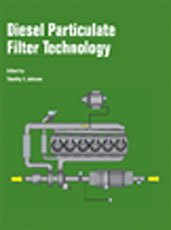Technical Paper
A New High Temperature Ceramic Material for Diesel Particulate Filter Applications
2000-10-16
2000-01-2844
Cordierite-based diesel particulate filters (DPFs) have been in use for heavy duty engine applications for nearly two decades. Recently, passenger car applications for DPFs have begun to appear in Europe due to tightening legislation. While cordierite-based DPFs work well in most applications, it appears that in the passenger car exhaust environment under some uncontrolled regeneration conditions, cracking and melting of the existing cordierite-based DPF products have been reported. The present paper focuses on the development of new, high temperature oxide ceramics for DPF passenger car applications. When designed properly, DPFs made from these new materials do not show cracking or melting under uncontrolled regeneration. The material properties (strength, elastic modulus, coefficient of thermal expansion, etc.) and the filter performance properties (pressure drop, regeneration durability, etc.) have been characterized for DPFs made from these new materials.

